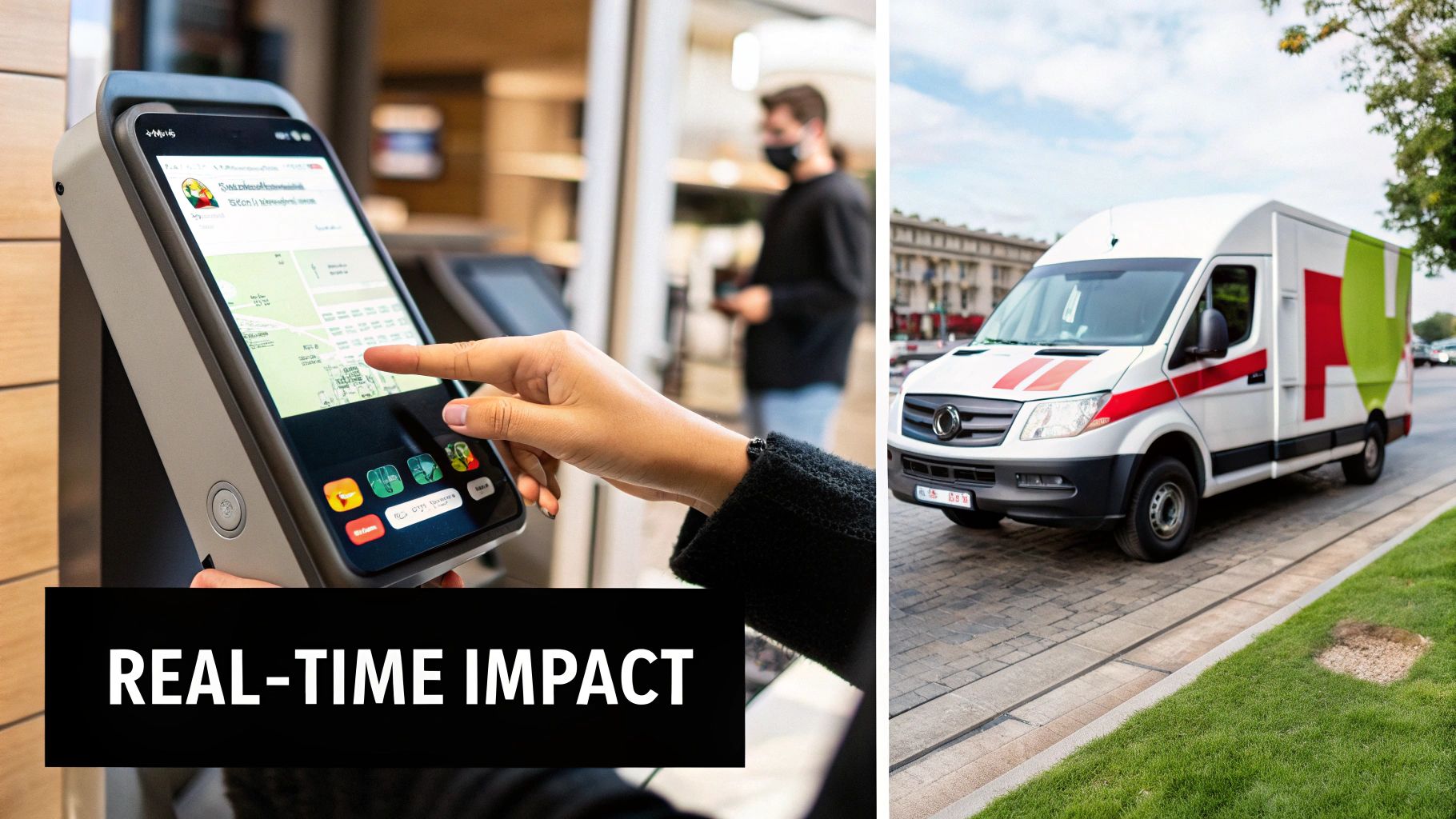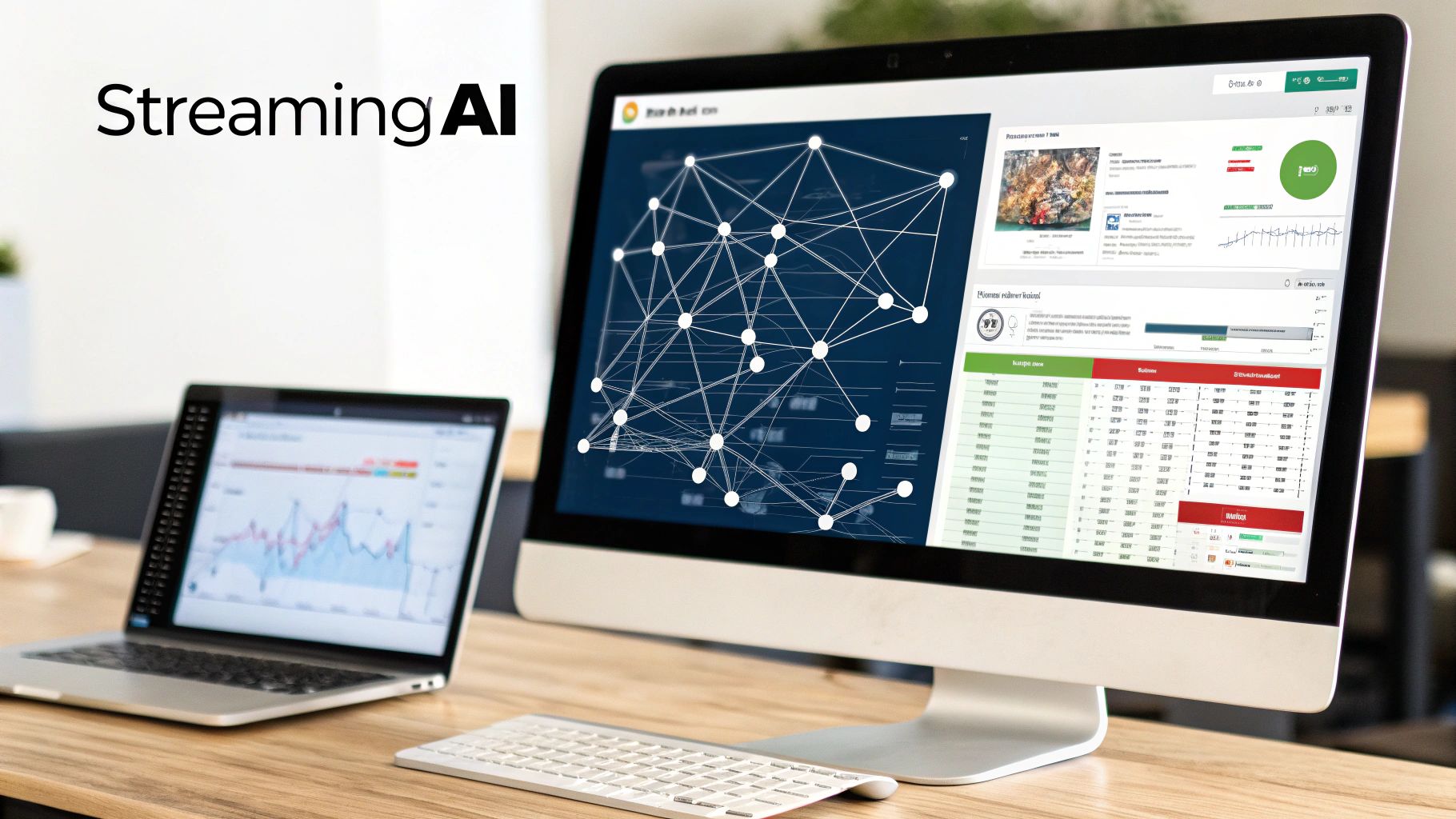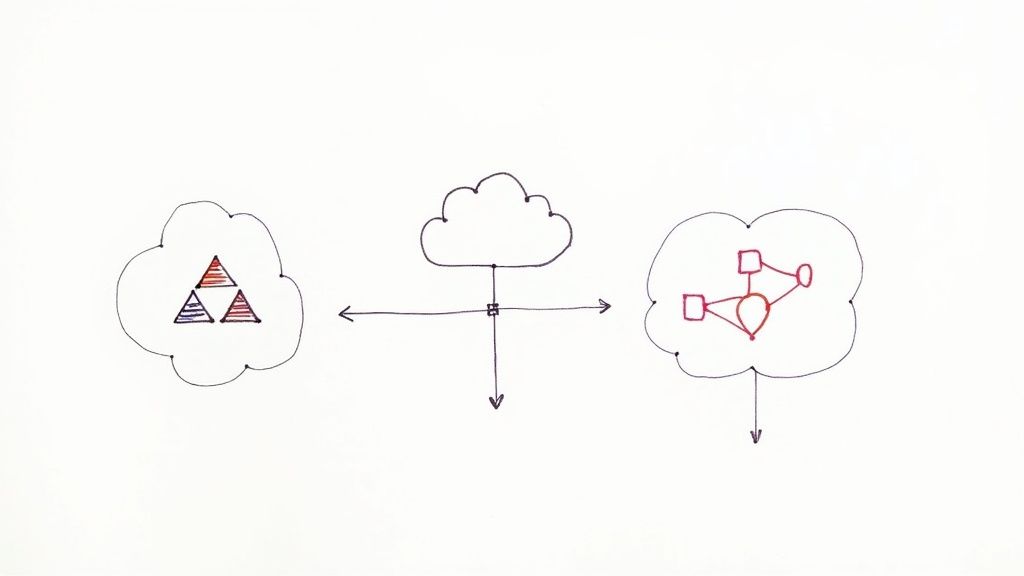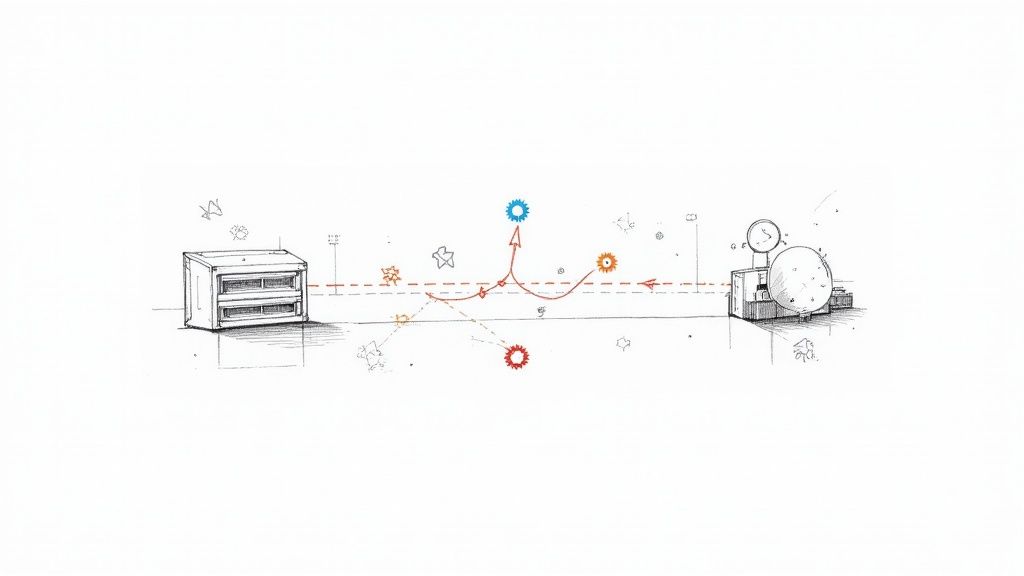Realtime Data Processing a Practical Guide
Explore realtime data processing with our guide to modern architectures, streaming analytics, and real-world use cases that drive instant business decisions.
Realtime data processing isn't just a technical term; it's about making decisions based on what’s happening right now. It’s the ability to analyze and act on information the very instant it comes into existence. This closes the gap between an event happening and your ability to respond, turning a reactive process into a proactive one.
From Waiting For Data To Acting On It Instantly
Think of it like watching a basketball game. You could wait for the morning paper to get a full box score and a summary of what happened. That’s useful information, but it’s a historical document. You’re looking at the past. This is how traditional batch processing works—data is gathered over time and processed in large, scheduled chunks.
But what if you were sitting courtside, watching every pass, shot, and foul as it unfolds? You're not just getting data later; you’re experiencing the game in the moment and can react to the flow of the game instantly. That's the core idea behind realtime data processing. You’re working with "data in motion," not "data at rest."
The Critical Shift To Instant Insights
Business today moves at the speed of a click. Customer behavior, market shifts, and operational issues don't wait for a nightly report. An item dropped into an online cart, a sudden temperature spike from a factory sensor, or a flagged financial transaction—these are all moments that lose their value with every second that ticks by.
If you wait for an end-of-day report to spot a fraudulent transaction, the money is already gone. Realtime processing eliminates that delay. It empowers you to:
- Stop fraud as the transaction is being attempted.
- Personalize a customer's experience while they're still browsing your site.
- Reroute supply chains based on live traffic and weather updates.
- Prevent equipment failure by analyzing performance metrics as they stream in.
This isn't a niche capability anymore; it's becoming a business necessity. The global real-time analytics market was valued at USD 890.2 million in 2024 and is expected to surge to USD 5,258.7 million by 2032. This incredible growth is driven by industries like finance, e-commerce, and healthcare, where a few seconds can make all the difference. For a detailed breakdown, you can check out the real-time analytics market research from Fortune Business Insights.
Realtime Versus Batch: A Clear Comparison
Putting these two approaches side-by-side really clarifies the difference. Batch processing absolutely still has its place for tasks that aren't time-sensitive, like running payroll or compiling monthly financial statements. But for anything requiring immediate action, realtime is the only way to go.
To dig deeper into this topic, our guide on the fundamentals of real-time data analytics offers a great starting point.
Here’s a simple table to break down the key distinctions.
Realtime Processing vs Batch Processing at a Glance
This table provides a clear, side-by-side comparison of the fundamental differences between realtime and traditional batch data processing methods.
CharacteristicRealtime Data ProcessingBatch Data ProcessingData ScopeProcesses individual events or small windows of data.Processes large, bounded volumes of data collected over time.LatencyMilliseconds to seconds.Minutes, hours, or even days.ThroughputHigh volume of small, continuous data packets.High volume of large, periodic data jobs.Ideal Use CasesFraud detection, live dashboards, IoT sensor monitoring.Billing systems, payroll processing, weekly sales reports.
As you can see, they are designed for fundamentally different jobs. The choice isn't about which one is "better," but which one is right for the task at hand.
Core Architectures for Real-Time Data Capture
To get the most out of real-time data, you first have to capture it the moment it's born. Constantly polling your databases every few seconds is like hitting refresh on a sold-out concert ticket page—it’s clunky, slow, and puts a ton of unnecessary strain on the system.
There’s a much smarter way: get an instant notification the second a ticket becomes available. This is the simple but powerful idea behind Change Data Capture (CDC).
CDC is a collection of design patterns that do exactly what the name implies: they watch a database and capture every single change—every new record, update, or deletion—the instant it happens. Instead of repeatedly asking the database "what's new?", CDC listens for change events directly. This is how you get data flowing from your live, operational databases into your analytics systems in a blink, forming the foundation of any modern real-time data strategy.
This chart shows the evolution perfectly. We've moved from slow, periodic checks to instant, continuous data capture.

You can see how the old way was cumbersome and created delays, while the new approach is a sleek, immediate process that lets you act on information right away.
Understanding CDC Methods
Not all CDC methods are created equal. They mostly fall into two camps, and knowing the difference is crucial for designing a pipeline that won't crumble under pressure. Each has its own pros and cons that make it a better fit for certain jobs.
1. Log-Based CDCThis is the gold standard for high-performance systems. Nearly all databases keep a transaction log (sometimes called a write-ahead log, or WAL) that meticulously records every change before it's even committed to the actual database tables. Log-based CDC taps directly into this log file.
- Benefit: It's incredibly light on its feet. Because it's not querying your production tables, it has virtually zero impact on your application's performance.
- Trade-off: Getting it set up can be tricky. You often need special database permissions or have to navigate some complex configurations to get access to the logs.
2. Trigger-Based CDCThis approach uses standard database triggers—little snippets of code that automatically run when a specific event happens, like an INSERT, UPDATE, or DELETE on a table. When a change is made, the trigger fires and copies a record of that change into a separate "history" table.
- Benefit: It’s easy to set up. Triggers are a standard feature in almost every relational database, making implementation a breeze.
- Trade-off: This method adds a tiny bit of extra work to every single database transaction. Under a heavy load, that tiny bit can add up and start to slow down your main application.
Key Takeaway: For anything performance-critical, log-based CDC is the way to go because it’s non-intrusive. Trigger-based CDC is simpler but at the cost of adding overhead to the source database itself.
The Role of Event-Driven Architectures
Okay, so you’ve captured these changes using CDC. Now what? Where do they go? This is where event-driven architectures enter the picture. Think of them as the central nervous system for your data.
Instead of one application directly calling another in a rigid, brittle chain, data is published as a continuous stream of events. Any other system that cares about that data can simply "subscribe" to the stream and react in real-time.
This approach decouples all your systems, letting them operate and scale independently. A single customer update in your main database can simultaneously trigger an alert in your fraud detection system, a refresh on an analytics dashboard, and a personalized email from your marketing platform—all without those systems ever needing to know the others exist.
Streaming Platforms: The Data Highway
The heart of any modern event-driven architecture is a streaming platform like Apache Kafka or a cloud-native service like Amazon Kinesis. These platforms are the superhighways built to handle an insane volume of data events, acting as a reliable and fault-tolerant buffer between all your different systems.
Here’s what they do for you:
- Ingest Data: They reliably vacuum up events from countless sources, whether it's a CDC tool, an IoT sensor, or a user clicking on your website.
- Store Data: They can hang on to these event streams for as long as you need, which is great for letting new applications process historical data or for recovering from a system failure.
- Distribute Data: They efficiently broadcast data to many different consumers at once without ever slowing down the systems producing the data.
This powerful pattern isn’t just for giant enterprises. You can see these same principles at a much more tangible scale when you look into how to implement MQTT in smart home setups, where devices communicate through a central broker.
By pairing CDC with a robust streaming platform, you build a resilient, scalable foundation for true real-time data processing.
Streaming vs. Batch Analytics: Which One Do You Need?
Choosing between streaming and batch analytics isn't just a technical debate—it’s a strategic one. It all boils down to a single, critical question: How fast do you really need your answers?
Think about it like this. If you’re running a huge e-commerce site, do you need a report on last week’s total sales, or do you need to know right now that a customer's credit card was just flagged for fraud? The answer to that question will shape your entire data strategy.
Batch analytics is like developing a roll of film. You capture all the light (your data) over a period, then process it all at once to get a complete, historical picture. This is perfect for things like generating monthly financial reports or looking back at how a marketing campaign performed after it ended.
Streaming analytics, on the other hand, is like watching a live video feed. It processes events the very moment they happen, giving you the immediate intelligence you need to act on the fly. This is the heart of modern real-time data processing, where the value of data can evaporate in seconds.
When to Use Streaming Analytics
Streaming analytics is your go-to when immediate action isn't just a nice-to-have, but an absolute necessity. The whole point is to spot patterns, catch anomalies, or jump on opportunities as the data flows in, allowing for a response in milliseconds or seconds.
Here are a few classic scenarios where streaming is the only game in town:
- Fraud Detection: An algorithm sifts through transaction data as it arrives, instantly blocking a sketchy purchase before the transaction can even go through.
- Dynamic Pricing: An airline’s pricing engine constantly tweaks ticket prices based on real-time demand, what competitors are doing, and how fast seats are selling.
- IoT Monitoring: On a factory floor, sensors stream data to predict equipment failure, triggering a maintenance alert the instant a machine starts showing signs of trouble.
When Batch Analytics Is the Right Choice
For all the buzz around real-time, batch processing is still essential for many core business functions. It's the workhorse for analyzing large, complete datasets where you don’t need an instant response. It’s also often much more cost-effective for chewing through massive volumes of data that aren't time-sensitive.
Batch processing is the perfect fit for:
- Billing and Payroll: These systems almost always run on a set schedule (like monthly), processing all the relevant data for that period in one big job.
- Comprehensive Reporting: To create quarterly sales summaries or annual reports on customer behavior, you need to analyze a complete historical dataset.
- Data Archiving: Moving huge chunks of old data from your live systems to a data warehouse is a classic batch operation.
At the end of the day, the decision comes down to business impact. If a delay of minutes or hours makes your data useless and stops you from taking critical action, you need streaming. If you need a complete, historical view for long-term strategic planning, batch is your best friend.
The push for instant insights is only getting stronger. The streaming analytics market hit USD 23.4 billion in 2023 and is on track to explode to USD 128.4 billion by 2030. This incredible growth is being driven by the boom in IoT devices and the fact that 72% of global organizations are now using event-driven architectures. You can dive deeper into these trends in this analysis of real-time data integration growth rates.
For a more detailed head-to-head, our guide on batch vs. stream processing breaks down both methodologies even further.
To help you make a clear-headed decision, let’s put these two approaches side-by-side.
Choosing Your Analytics Approach: Streaming vs. Batch
Making the right choice between streaming and batch analytics is crucial. This table breaks down the key differences to help you align your data strategy with your business needs for speed, accuracy, and cost.
Evaluation CriteriaStreaming AnalyticsBatch AnalyticsData LatencyNear-zero (milliseconds to seconds). Data is processed as it arrives.High (minutes to days). Data is processed on a scheduled basis.Data ScopeProcesses individual events or small, time-based windows of data.Processes large, finite datasets collected over a specific period.Ideal Use CaseReal-time fraud detection, live dashboards, IoT sensor alerts.Weekly sales reports, payroll processing, customer churn analysis.Infrastructure CostCan be higher due to the need for always-on, low-latency systems.Generally lower as processing can be done on cheaper, off-peak resources.Analysis TypePrimarily focused on detecting immediate patterns and anomalies.Focused on deep, complex queries over large historical datasets.
Ultimately, the best approach depends entirely on what you're trying to achieve. While the world is clearly moving toward real-time, batch processing remains a powerful and cost-effective tool for the right job.
How Real-Time Data Processing Is Used in the Real World

It's one thing to talk about theories and architectures, but it's another to see real-time data processing in the wild. This isn't just an abstract concept for engineers to debate; it’s a powerful tool that’s actively reshaping how entire industries operate, from digital storefronts to the factory floor. Looking at how different sectors use this technology shows the tangible impact of acting on data the second it’s created.
The need for this is exploding. The global datasphere is projected to hit an almost unimaginable 181 zettabytes by 2025, with IoT devices alone contributing over 73 zettabytes. This wave of information is what’s pushing the data analytics market to projected heights of over USD 658.64 billion by 2034, up from USD 64.75 billion in 2025. You can dig into the specifics in the full data analytics market report from Precedence Research.
All that data is just noise if you can't process it instantly. Let’s break down how some of the most competitive industries are turning this data deluge into a serious advantage.
E-commerce and Dynamic Customer Experiences
The world of online retail moves at lightning speed. For any e-commerce platform, latency isn't just a nuisance—it's a revenue killer. Real-time data processing is the engine that drives the seamless, personalized experiences that shoppers now expect as standard.
Think about a massive flash sale. Thousands of people are trying to add the same hot-ticket item to their carts at the exact same time.
- The Challenge: In a batch-based system, the inventory count is always out of date. The store would almost certainly oversell the product, creating a nightmare of canceled orders, angry customers, and a swamped support team.
- The Real-Time Solution: Every single "add to cart" click is an event streamed and processed instantly. The inventory database is updated in milliseconds, so the "out of stock" message pops up the very moment the last item is gone.
- The Impact: This simple change prevents overselling and protects customer trust. But it goes further, powering dynamic pricing that adjusts to live demand or offering personalized recommendations based on what a user is clicking on right now.
Financial Services and Instant Fraud Detection
In finance, a few seconds can be the difference between a secure transaction and a major financial loss. This is why financial institutions were some of the earliest adopters of real-time data processing, all for one critical reason: fraud prevention.
When a transaction occurs, the window to act is microscopic. Real-time analytics doesn't just report on fraud after the fact; it intervenes to stop it from ever completing. This proactive stance is a fundamental shift in security strategy.
Every credit card transaction generates a stream of data points—the amount, the merchant, the location, the time, the device. A streaming analytics engine cross-references this live data against a person's historical patterns and a complex set of rules, all in milliseconds.
If a card that was just used in Chicago suddenly makes an online purchase from another country a minute later, the system flags it instantly. The transaction is blocked before it's approved, and the cardholder gets an alert. It's not just about stopping a fraudulent charge; it's about building unbreakable trust. As new data sources emerge, like in blockchain data analysis, this real-time capability becomes even more essential.
Logistics and Supply Chain Optimization
A modern supply chain is an incredibly complex web of moving parts, where one small delay can trigger a massive ripple effect down the line. Logistics companies now depend on real-time data to keep everything moving efficiently, from the warehouse shelf to a customer's doorstep.
Imagine a fleet of delivery trucks navigating a busy city.
- The Old Way: Drivers would just follow a static route planned at the beginning of their shift.
- The Real-Time Way: GPS data streams from every truck to a central hub, where it’s merged with live traffic feeds, weather alerts, and even unexpected road closures.
- The Result: The system is constantly re-optimizing routes on the fly. It can guide a driver around a sudden accident or adjust delivery windows based on new information, ensuring packages arrive on time while cutting fuel costs. The same principle applies to managing warehouse inventory, tracking cargo containers across oceans, and predicting demand spikes before they happen.
Navigating Common Performance Challenges
Moving to a real-time data processing system is a bit like swapping out a garden hose for a fire hose. Sure, they both move water, but the fire hose operates under immense pressure. Even a tiny leak can become a massive problem in seconds. In the same way, real-time systems introduce some unique performance hurdles that demand careful, deliberate engineering.
If you want to build a successful streaming architecture, you have to get a handle on three critical metrics: latency, throughput, and scalability. These aren't just buzzwords; they're the vital signs that tell you how healthy your data pipeline really is.
Keeping Latency Under Control
Latency is simply the travel time for a single piece of data to get from its source all the way to its destination where it can be analyzed. For any real-time system, this is the metric that matters most. After all, high latency completely defeats the purpose of trying to process data in the moment.
Think about a fraud detection system. If it takes 10 seconds to flag a suspicious transaction, the thief is already out the door with the goods. The whole point is to shrink that delay down to milliseconds. The best ways to do this involve minimizing network hops, picking efficient data formats, and writing lean, optimized processing logic. For a deeper dive, our guide on how to reduce latency in data systems offers some really practical strategies.
Maximizing Throughput Without Sacrificing Speed
Throughput is all about how much data your system can chew through in a set amount of time. It’s the total volume of events you can reliably process before things start backing up and creating a bottleneck. It's one thing to have low latency for a single event, but a completely different challenge when you're getting slammed with thousands of events every second.
Real performance is about keeping that latency low even as throughput soars. To get there, engineers often rely on a few key techniques:
- Partitioning Data: This means splitting data streams into smaller, parallel tracks. It's like a supermarket opening up more checkout lanes during a rush—it lets you process more, faster.
- Load Balancing: This is about spreading the work evenly across multiple servers. It ensures no single machine gets overloaded and becomes the weak link in the chain.
- Efficient Serialization: Using compact data formats like Avro or Protocol Buffers shrinks the size of your data packets, meaning you can send more information across the network without clogging it up.
Designing for Scalability and Fault Tolerance
Your system has to be ready to grow as your data volume inevitably does. Scalability is your architecture's ability to handle a bigger load just by adding more resources. This is usually done with horizontal scaling—adding more machines to a cluster—which is far more practical than trying to build a single, infinitely powerful server.
At the same time, you have to plan for failure, because it will happen. Fault tolerance is what ensures your pipeline can survive a component failure without losing data or grinding to a halt.
This is where technologies like Apache Kafka really prove their worth. Kafka was built from the ground up to replicate data across multiple nodes. If one server fails, another one is ready to pick up the slack instantly. Without this kind of resilience, a simple server reboot could stop your entire real-time operation or, even worse, cause permanent data loss. On top of that, you have to worry about keeping data consistent across this distributed setup, which adds another layer of complexity to get right.
The Future of Realtime Data and AI Integration

The move from batch processing to streaming architectures has been a game-changer for how businesses work. We've gone from looking in the rearview mirror at historical data to acting on information the second it’s born. This shift, driven by tools like Change Data Capture (CDC) and modern streaming platforms, isn't just a fancy extra anymore—it's quickly becoming the baseline for staying in the game.
Being able to work with data in motion has opened doors to things we could only dream of before, like stopping fraud while a transaction is still happening or tailoring a website to a user as they click around. But the story of realtime data processing doesn't end there. The next big chapter is all about its deep-seated connection with Artificial Intelligence (AI) and Machine Learning (ML).
From Realtime Insights to Automated Actions
Pairing AI with live data streams is where the real magic happens. It’s the final piece of the puzzle, bridging the gap between seeing an insight and actually doing something about it. Instead of a person staring at a dashboard trying to figure out the next move, an AI model can be plugged right into the data pipeline to make that call in a fraction of a second.
This creates a whole new world of operational intelligence, where systems can fix themselves, get smarter, and react on their own. Suddenly, your data isn't just a record of what happened; it's an active player in making your business better.
This shift moves companies from a "detect and alert" model to a "predict and prevent" strategy. It's the difference between knowing a problem happened and stopping it from ever occurring.
Emerging AI-Driven Use Cases
This powerful combination is already setting the stage for the next wave of data-powered applications. We're starting to see incredibly smart systems that can learn and adjust to new information instantly.
Here’s a little taste of what this future looks like in practice:
- Hyper-Personalization: Imagine an e-commerce site where an AI watches how you browse, checks it against your past behavior, and cooks up a personalized set of recommendations and deals for you—all in the time it takes to click to the next page.
- Predictive Maintenance: On a factory floor, ML models can listen to the constant stream of data from machinery sensors. Instead of just throwing up a red flag when something breaks, the model can predict a failure hours before it happens and automatically book a maintenance slot to avoid any downtime.
- Autonomous Supply Chains: A logistics company could use AI to do more than just route a truck around a traffic jam. It could spot a surge in demand by monitoring social media trends and automatically move inventory to the right place before anyone even knows they need it.
Bringing AI into the mix turns realtime data processing from a simple analysis tool into a powerful engine for autonomous action. It’s no longer just a part of the business toolkit—it’s becoming the foundation for how modern companies innovate and grow.
Frequently Asked Questions
What's The Difference Between Stream and Batch Processing?
It all comes down to timing. Stream processing is about analyzing data the very moment it's created, piece by piece, in real time. Think of it like a live news ticker—you see updates as they happen.
Batch processing, on the other hand, is more patient. It gathers data over a set period—maybe an hour, maybe a full day—and then processes it all in one large, scheduled job. This is like waiting for the morning newspaper to get a summary of yesterday's events.
Is Change Data Capture The Only Way to Get Real-Time Data?
While Change Data Capture (CDC) has become a go-to method for its efficiency, it's not the only game in town for real-time data processing. You'll also see other approaches, such as:
- Message Queues: Applications can send event data directly to a message broker like RabbitMQ or Amazon SQS for other systems to pick up instantly.
- API Polling: This involves repeatedly asking an API, "Anything new yet?" It can work, but it's often inefficient and creates delays, so it isn't truly real-time.
For databases, though, CDC is often the top choice. It’s a clean, low-impact way to capture every single change with minimal delay and without bogging down your production systems.
What Are The Toughest Parts of Building a Real-Time Data System?
Building a real-time system is a different beast than working with traditional batch pipelines. The challenges are unique and require careful planning.
For starters, you have to guarantee data arrives in the right order and is processed exactly once. Nobody wants duplicate records or missing information. You also need to build a system that can handle failures gracefully without losing a single byte of data.
The top challenges include ensuring data ordering and exactly-once processing to avoid duplicates or missed data, managing system state reliably, and ensuring high availability and fault tolerance so the system can recover from failures without data loss.
Beyond that, keeping data consistent across different distributed systems is a major hurdle. The overall complexity of managing a streaming architecture—with its many moving parts—can be a significant jump for teams used to simpler batch setups.
Ready to build a powerful, low-latency data pipeline without all the complexity? Streamkap uses modern CDC to help you replace slow batch jobs with efficient, real-time data streaming. See how you can sync your data instantly.



